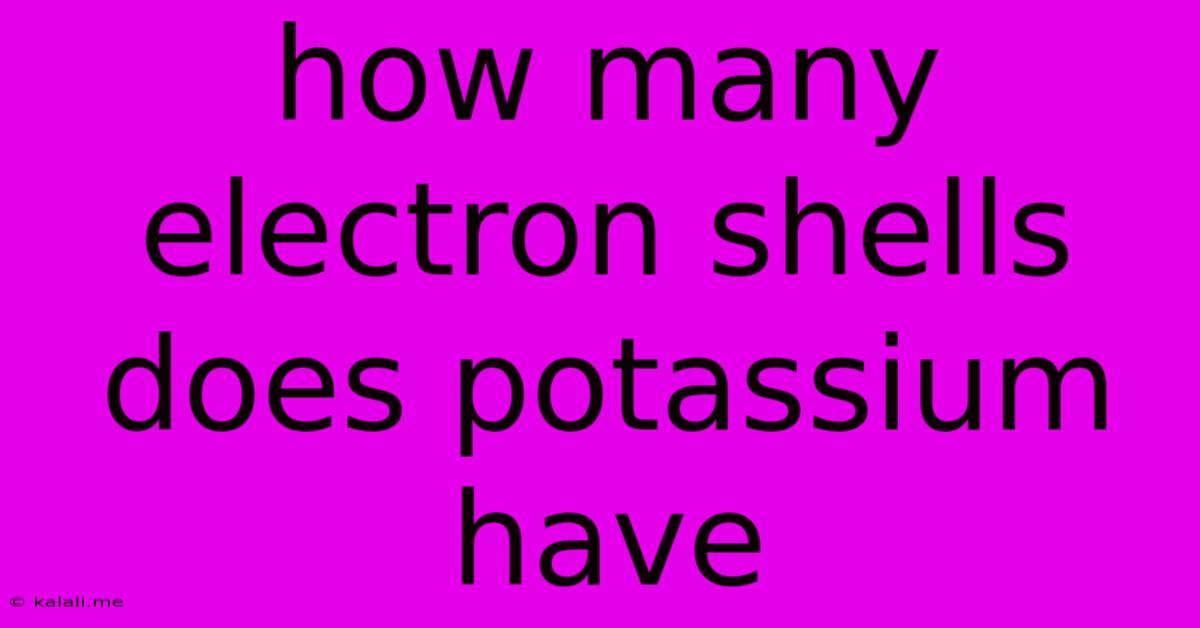How Many Electron Shells Does Potassium Have
Kalali
Jun 14, 2025 · 2 min read

Table of Contents
How Many Electron Shells Does Potassium Have? Understanding Potassium's Atomic Structure
Potassium, a vital element for human health and a common component in fertilizers, boasts a fascinating atomic structure. This article will delve into the specifics of potassium's electron configuration, explaining exactly how many electron shells it possesses and why this arrangement is crucial to its chemical properties. Understanding potassium's electron shells is key to comprehending its reactivity and role in various biological and industrial processes.
Potassium (K), with an atomic number of 19, signifies that a neutral potassium atom contains 19 protons and 19 electrons. These electrons are arranged in specific energy levels or shells, orbiting the nucleus. The number of electron shells determines an element's chemical behavior and its position within the periodic table.
Electron Shell Configuration of Potassium
The electrons in a potassium atom are distributed across three main electron shells:
- First shell (n=1): This shell, closest to the nucleus, can hold a maximum of two electrons. In potassium, this inner shell is completely filled with two electrons.
- Second shell (n=2): This shell has a capacity of eight electrons. Potassium's second shell is also completely filled, holding its full complement of eight electrons.
- Third shell (n=3): This shell can accommodate up to 18 electrons, but in potassium, it only contains eight electrons.
- Fourth shell (n=4): The outermost shell, also known as the valence shell, contains the remaining single electron. This single valence electron is what dictates potassium's reactivity.
Therefore, potassium has four electron shells.
The Significance of the Fourth Shell
The presence of a single electron in potassium's outermost shell is critical to its chemical properties. This lone electron is easily lost, making potassium highly reactive and readily forming a +1 ion (K⁺). This ease of losing an electron contributes to potassium's metallic character and its ability to readily participate in ionic bonding. This single electron also explains potassium's location in Group 1 (alkali metals) of the periodic table, a group known for its highly reactive elements.
Potassium's Role in Biology and Beyond
The chemical reactivity facilitated by its electron configuration makes potassium essential for various biological processes. It plays a vital role in nerve impulse transmission, muscle contraction, and maintaining proper fluid balance within the body. Understanding the atomic structure of potassium, particularly its electron shells, provides crucial insights into its biological functions and its widespread applications in agriculture and industry.
In conclusion, potassium possesses four electron shells, with a single electron in its outermost shell driving its reactivity and shaping its role in numerous chemical and biological contexts. Its unique electron configuration is fundamental to understanding its behavior and importance in various applications.
Latest Posts
Latest Posts
-
A Store Sells Two Different Sized Containers Of Blueberries
Jun 14, 2025
-
Which Trophic Level Contains The Most Energy
Jun 14, 2025
-
What Is The Smallest Particle In Soil
Jun 14, 2025
-
Least Common Multiple Of 18 And 36
Jun 14, 2025
-
Diego One Of Two Joint Winners
Jun 14, 2025
Related Post
Thank you for visiting our website which covers about How Many Electron Shells Does Potassium Have . We hope the information provided has been useful to you. Feel free to contact us if you have any questions or need further assistance. See you next time and don't miss to bookmark.